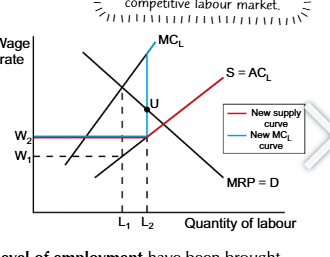3.5.3 Wage determination in competitive and non-competitive markets
1/46
There's no tags or description
Looks like no tags are added yet.
Name | Mastery | Learn | Test | Matching | Spaced |
|---|
No study sessions yet.
47 Terms
labour market equilibrium
where demand for labour is equal to supply of labour
what are individual firms in labour market
price takers as they have to accept the wage rate that workers are being paid in the industry
what happens if firms offer a lower or higher wage than wage rate
If they offer a lower wage, they will likely struggle to recruit workers
If they offer a higher wage there will be a large number of workers applying to work there
demand and supply of labour graph
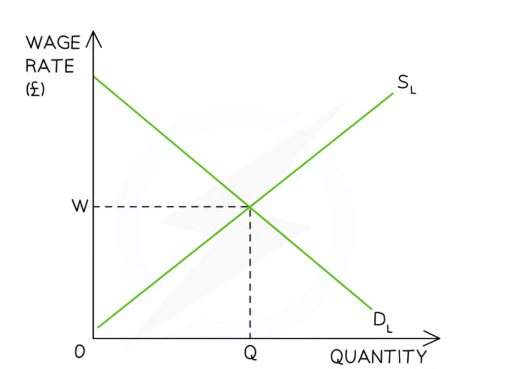
what can the demand curve for labour also be called
MRP curve
current labour market issues
skills shortages
youth and graduate unemployment
changes to retirement age
school leaving ages
zero hour contracts
temporary/flexible working
increased technology-job loss
strikes-tube
labour shortages - brexit
gender pay gap
skills shortages in uk labour market
In December 2021 more than 50% of firms surveyed reported difficulties in finding skilled workers
A shortage of skilled labour means that firms are having to increase wage rates to attract labour
Firms are effectively poaching skilled labour from each other and there is a shortage of new skilled labour entering the market
Some of the many labour markets experiencing shortages include nursing, engineering, pharmacies, secondary teaching, and graphic design
youth unemployment in uk labour market
Unemployment for 16-24 year olds in April 2022 was at 10.8% compared to the general unemployment rate of 3.8%
This means that it is nearly three times as likely for a young person to be unemployed
Where possible employers prefer to hire workers with more experience as it can lead to higher productivity
The education or skills gap is another reason for youth unemployment. Young people leave school without the skills that employers require
changes to retirement ages issues in labour market
In 1995 the state retirement age was 60 for women and 65 for men
In recent years, State Pension reform has been ongoing and the retirement age is gradually being increased to 68 for both men and women
This means that workers are expected to remain in the workforce for longer
One reason for the change is that with too many pensioners in the system, it is difficult for the government to fund monthly pension payments
An improvement to life expectancy has meant there are more pensioners in the system
school leaving age 9n uk labour market
The earlier a student leaves school the lower their skill level
Different policies are in place in England as compared with Scotland, Northern Ireland and Wales
In the latter three the school leaving age is 16 and there are no further conditions in place
In England,students can leave school at 16 but have to do one of the following until they are 18
Stay in full-time education, e.g. at a college
Start an apprenticeship or traineeship
Spend 20 hours or more a week working or volunteering, while in part-time education or training
This aims to increase the skill level but also puts increased pressure on training providers
There are not enough apprenticeships to match the demand
zero hour contracts labour market
In 2022, nearly 1 million workers were on zero-hour contracts which is more than five times the number in 2000
These contracts are extremely beneficial to employers
Workers are not guaranteed work and only get paid for the work they do
Workers do not receive many of the benefits that full-time employees receive - this reduces costs for the firm
Some workers do enjoy the flexibility this provides as they can sign contracts with several firms and sometimes enjoy a wider variety of work
These contracts change unemployment figures as workers may not end up receiving much work, but are no longer counted as unemployed
Temporary/flexible working uk labour market
Flexible working is working in such a way that it meets the employee's needs
Covid19 has driven changes in thinking around where work happens
Many workers now want to work from home Some employers prefer this as it lowers company costs
Other employers are insisting on a return to the workplace as it is required, or they want more control over their workforce
There is an increasing focus on well-being and more people are opting to work part-time jobs or jobs that offer more flexibility
government intervention in labour market
max and min wages
public sector wage setting
maximum wage
government imposed price ceiling below the market price and is rarely used
who has their been discussions about setting max wages for
There has been some discussion recently to set maximum wages for CEOs as their wages in early 2022 were 86x the average wage of full-time employees
If CEOs were paid less then the average pay per worker may increase
minimum wage
legally imposed wage level that employers must pay their workers
how does the minimum wage vary
varies based on age
minimum wage diagram
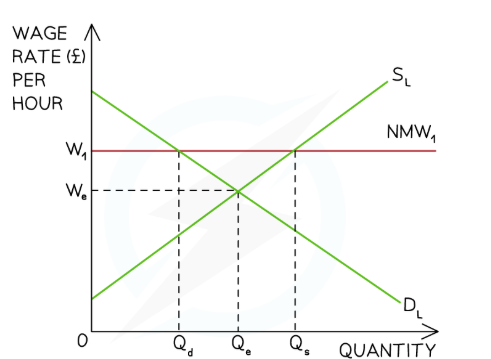
max wage diagram
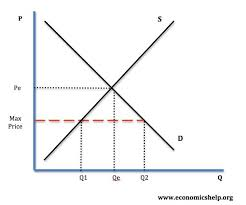
why doesnt minimum wage automatically increase unemployment
Many studies have shown that unemployment does not increase - and in some instances employment increases. This is likely due to the fact that workers are receiving higher wages and choose to consume more. This increases aggregate demand (AD) in the economy which in turn increases the demand for labour by firms - thus eradicating any potential real wage unemployment.
who is the larger employer in UK
government
how many public sector workers
In April 2022 there were 5.74 million public sector workers out of a total of 29.6 million employed workers (19.39%)
public sector wage setting
In many industries, the UK Government is the dominant employer and so is able to exercise monopsony power in setting the wage rates
implications of public sector wage setting
If the government increases the NMW, they are significantly increasing their own wage bill
The private sector often uses public sector wages as a benchmark for their own wage calculations
If public sector wages increase and private sector ones do not, it can create tension between workers in the different sectors
Increases to public sector pay often have to be paid for by increases in tax rates for the entire working population
when and why did public sector workers strike
In June 2022, public sector workers were striking due to issues with the pay increases offered by the Government
Worker's wages were frozen from 2010 to 2015 after the 2008 global financial crisis
This was followed by rampant inflation and wage increases well below the level of inflation
policies to tackle labour market immobility
improved education/training
targeted skills shortages
subsidising employers
relocation subsidies
reducing information asymmetry to help workers quickly identify new opportunities
reducing discrimination
wage differentials
differences in wages arising between individuals, occupations,industries,firms and regions
reasons for labour differentials
different workers have different MRPs
workers have different skills and preferences
labour market discrimination
compensating differentiaks
positive discrimination
when a group of workers are treated more favorably than others
negative discrimination
when a group of workers are treated less favourablt than others
could the laest rise in min wage affect jobs
mw and ni increases
small businesses with low profit margins struggke
incentivise firms to invest in tech
increase consumer spending
improved productivity
attracts more skilled and motivated workers
advantages for minimum wage
equity justification
poverty reduction
incentives
anti discrimination
disadvantages of min wage
job losses
raise costs
wage spiral
rea living wage
only rate independently calculated annually based on the real cost of living
national livign wage
legal minimum hourly wage that employers must pay to workers aged 21 and over in the UK
arguments for maximum wage
reduce inflation
reduce inequality
reduces labor costs and increases demand for workers
arguments against max wage
should reward greater effort and ability with more pay
higher pay - increased productivity as higher motivation
emigration - move to countries with no wage cap
wage determination in perfectly comptitive kabour market
wages determind by demand and supply
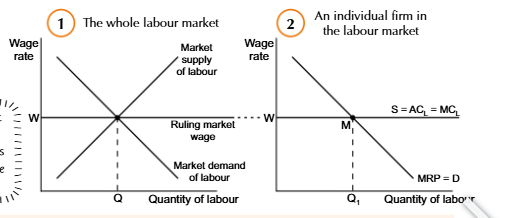
monopsony labour market
singe employer so only one choice of employer to work for
pay less than a workers MRP
marginal cost of labour curve is above average cost of labour curve as each time worker hired firm has to pay higher wage to attracte and also increase existing workers wages
firms will hire number that maximise profits where MRP meets MC
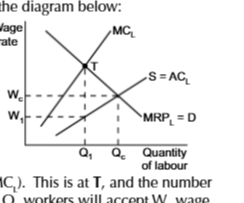
monopoly in labour market
The existence of trade unions means they can operate as the only seller of labour
trade union
organisation formed to reprsent interests of a group of workets
collective bargaining
trade union negottiates with employers
productivity bargains
unions agreee to specific changes that will increase productivity in return for higher wages
what rule in teachers union
must habve degree
how has government reduced power of trade union
introduced postal ballots, outlawed secondary picketing, restricted the size of the picket
line and forced unions to provide 14 days’ notice of action. The Trade Union Act 2016 was
the most recent act, and this included a clause saying that at least 50% of people must vote
in the ballot; the most recent teachers union ballot only had 28% voting turnout
how can trade unions cause labour market failure
forcing wages u to a level higher than market equilibrium wage
bilateral monopoly
trade union enters monosonistic labor market
single buyer and seller
trad eunion increase wage
